
Should You Paint Or Stain Your Deck
Introduction
Your deck is an extension of your home, but the elements can take a toll on its appearance and durability. Choosing between painting or staining your deck is a big decision, and understanding the difference between the two can help you make the best choice. This guide will walk you through the pros and cons of paint versus stain, explain why solid color stain might be the best of both worlds, and emphasize why regular paint isn’t a good option for decks.
1. Paint vs. Stain: What’s the Difference?
Paint and stain might seem similar, but they’re very different in how they protect and enhance your deck.
Paint: Paint sits on top of the wood, forming a thick layer that hides the natural grain. It offers bold color options and excellent durability, but it can chip and peel over time, especially in outdoor conditions.
Stain: Stain penetrates the wood, soaking in to enhance the natural texture and grain. It’s available in a variety of finishes, from transparent to solid color. Stain doesn’t peel or chip but may fade over time, requiring reapplication.
The choice often comes down to whether you want to highlight the wood’s natural beauty or prefer a uniform, painted look.
2. Why Regular Paint Isn’t Ideal for Decks
While paint is durable on walls or trim, it’s not a great fit for a deck. Decks face constant foot traffic, temperature changes, and moisture, all of which can cause paint to crack, peel, or bubble. Once this happens, repairing or repainting is a time-consuming process that involves scraping, sanding, and starting over.
If you love the look of paint but want something designed to handle the wear and tear of a deck, solid color stain is a much better choice.
3. The Case for Solid Color Stain
Solid color stain gives you the best of both worlds—it looks like paint but performs like a stain. Here’s why it’s such a great option:
Durability: Unlike paint, solid color stain penetrates the wood and forms a bond, which means it won’t peel or chip like paint can.
Protection: It offers excellent UV and moisture resistance, helping your deck withstand the elements.
Low Maintenance: When it’s time to refresh your deck, you can often apply a new coat without having to scrape or sand the old one.
Plus, solid color stain comes in a wide variety of colors, so you can achieve the painted look you love while still getting the benefits of a stain.
4. Preparing Your Deck for Paint or Stain
No matter which option you choose, preparation is key to a lasting finish. Follow these steps for the best results:
Clean Thoroughly: Use a deck cleaner to remove dirt, mold, and mildew.
Repair and Sand: Fix any damaged boards and sand rough areas to ensure an even surface.
Choose the Right Product: Select a paint or stain specifically designed for decks—never use regular wall paint.
Apply Properly: Use a brush, roller, or a specialty applicator for even coverage, and apply thin coats, allowing each coat to dry fully before adding the next.
5. Choosing the Right Stain: Solid, Semi-Transparent, or Transparent
When it comes to staining your deck, you’ll need to decide between solid, semi-transparent, or transparent stain. Each option has its own advantages, depending on the condition of your deck and the look you want to achieve.
Solid Color Stain: If your deck is older and has imperfections like cracks, discoloration, or uneven wood grain, solid stain is your best bet. It provides a finish that looks like paint, covering up blemishes while still allowing the wood texture to show slightly. This is also a great choice if you want a bold, uniform color that matches your home’s aesthetic.
Semi-Transparent Stain: For a balance between natural wood grain and color, semi-transparent stain is ideal. It enhances the wood's natural texture while adding some color and protection. This option works well on decks that are in good condition but may have some minor imperfections.
Transparent Stain: If your deck is newer or made of beautiful, high-quality wood, transparent stain lets the natural grain and beauty of the wood shine through. It provides minimal color but still offers essential protection against UV rays and moisture. This option is perfect for showcasing wood like cedar, redwood, or pressure-treated pine.
Choosing the right type of stain comes down to how much of the wood’s natural character you want to highlight and how much coverage or repair the deck needs. Keep in mind that solid stain offers the longest-lasting coverage, while transparent stains may require more frequent reapplication to maintain their look.
6. Maintaining Your Deck’s Finish
To keep your deck looking its best, regular maintenance is a must:
Sweep regularly to remove debris.
Clean the surface once or twice a year with a deck-safe cleaner.
Inspect annually for signs of wear and touch up as needed.
Conclusion
Whether you choose transparent, semi-transparent, or solid color stain, the key is picking the right product for your deck’s needs. Solid color stain offers the painted look many people love without the peeling and chipping issues of regular paint, making it a smart choice for most decks. With the right prep and maintenance, your deck can stay beautiful and protected for years to come. Ready to start your project? Give Rockford Painting Pros a call!
